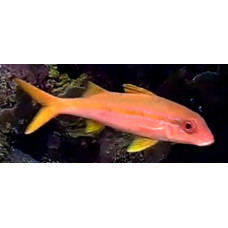Latin name
Mulloidichthys vanicolensis
Other names
Golden banded goatfish, gold stripe goatfish, goldenstripe goatfish, goldstripe goatfish, banded goatfish, yellowstripe goatfish.
Identification
The body is elongated, slightly compressed at the sides, its height is 3.4-4.5 times the standard body length. The length of the head is 2.95-3.4 times the length of the body. There are two slender chin tendrils. The snout is rather short, its length is 2-2.5 times less than the length of the head. The mouth is small, the tip of the upper jaw does not reach the vertical line passing through the front edge of the eye. The bristle-like teeth are arranged in a band on both jaws; there are no teeth on the palate and scutellum. There are 31-36 gill stamens on the first gill arch. The lateral line is complete, with 33-38 scales entering the base of the caudal fin. The caudal peduncle is long, with 11-12 rows of scales along the upper edge.
Features of fish fins
The tail fin is forked. Two dorsal fins with 5 transverse rows of scales between them. The first dorsal fin has 8 barbed rays (the first barb is very small) and the second has 9 soft rays. The anal fin has one barb and 6 soft rays. Pectoral fins have 15-18 soft rays. The pelvic fins have 1 barb and 5 soft rays.
Fish colouring
Upper body above lateral line yellow, lower body silvery white. Head below eyes and behind jaws silvery white to light pink; snout dark pink and yellowish above eyes. A straight yellow stripe runs down the centre of the body from the eye to the base of the caudal fin; its width is about the diameter of the pupil, widening towards the caudal peduncle. There is no black spot on it. On either side of this band, from the eye to the end of the base of the anal fin, there are narrow pale blue (sometimes whitish) stripes. Dorsal, ventral, anal and caudal fins yellow; pectoral fins colourless. Chin antennas are white.
Distribution
Widespread in the Indo-Pacific region. Indian Ocean: from the Red Sea along the east coast of Africa to south of Mozambique and Mauritius; French Polynesia, Indonesia; western Pacific: south of Japan, Oceania, New Caledonia, Hawaiian Islands, Australia.
Habitat
Marine benthic fishes. They live in coastal waters, usually in sheltered lagoons and bays near coral reefs over sandy substrates at depths of 1 to 113 metres.
Size
Maximum body length 38 cm. Common size is up to 25 cm. Maximum published weight 1.1 kg.
Behavior
During the day they are inactive and form small flocks; at night they disperse and hunt individually. Sometimes mixed with Lutjanus kasmira.
Food and feeding habits
Find prey in the sand with sensitive chin antennae. Feeds on benthic invertebrates including small crabs, shrimps and other crustaceans; brittle stars, polychaete worms, sea urchins, foraminifera.
Reproduction
Little is known about their mode of reproduction. Their eggs are trapped in the substrate and they have a long larval period. Once the antennae begin to form, they become bottom dwellers.
Fishing
Commercial and sport fishing.
Relationship with a person
| Classification | |
| Phylum | Chordata |
| Class | Actinopterygii |
| Squad | Perciformes |
| Family | Mullidae |
| Genus | Mulloidichthys |
| Species | M. vanicolensis |
| Features | |
| Conservation status | Least Concern |
| Habitat | Bottom |
| Life span, years | No information |
| Maximum body weight, kg | 1,1 |
| Maximum length, cm | 38 |
| Sailing speed, m/s | No information |
| Threat to people | Edible |
| Way of eating | Planktonophage |
Yellowfin goatfish
Tags: yellowfin goatfish


